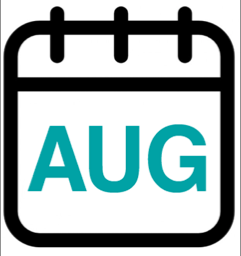 Is the morning of the first day of school a frenetic, crazy time at your house? How about the next few days? Whether your child is elementary- or high-school bound, it’s hard to get her up and moving in the morning and to bed at a reasonable time. Once she’s awake, then comes figuring out what to wear, a frantic search for the missing shoe because another pair isn’t acceptable, followed by general chaos that causes wasted time, drama and stress!
Is the morning of the first day of school a frenetic, crazy time at your house? How about the next few days? Whether your child is elementary- or high-school bound, it’s hard to get her up and moving in the morning and to bed at a reasonable time. Once she’s awake, then comes figuring out what to wear, a frantic search for the missing shoe because another pair isn’t acceptable, followed by general chaos that causes wasted time, drama and stress!
It doesn’t have to be this way. With some simple planning and organization, things can run smoothly. Whether your child is starting school for the first time or a returning student, these tips will ease the transition from summer to school.
Being organized makes life so much easier. As one of my favorite clients said upon completing his project, “Peace through organization.”
 Have you ever heard of BOGO? What about FOMO or YOLO?
Have you ever heard of BOGO? What about FOMO or YOLO?
These acronyms are clever and catchy:
BOGO: Buy One, Get One is an advertising phrase that encourages people to purchase because of the promise of a second item…whether they need it or not.
FOMO: Fear Of Missing Out is a phenomenon where people refuse to commit to plans or feel less present in their current activity because they wonder what they’re missing (that might be more fun).
YOLO: You Only Live Once is my youngest daughter’s favorite.
Ever heard of AUG? Don’t worry if you haven’t. Other than being the abbreviated version for this month, it is my attempt to be clever by encouraging de-cluttering throughout August. AUG stands for Anything Unused Goes!
AUG is an acronym that is very flexible. I invite you to get creative with the different ways you can use it to clear unused, useless and unworthy things from your life, space and storage areas.
How do you decide worth or usefulness? Please don’t decide worth solely by how much you spent or invested in something. Real worth is defined by how valuable it is to you today. Decide how necessary your stuff is to your life and its worth of the space it’s taking up in your home, car or office.
Lots of folks confuse usefulness with an item’s ability to still be useful – without considering if that item is of actual use to them. Today, there are so many ways to donate, repurpose and recycle things. Don’t hold onto things that clutter YOUR life. Let Anything Unused Go!
 Sometimes the simplest things make a huge difference. We spend a lot of time on computers, and if we could do what we needed to do faster, there would be more time to do the things we want to do. Here are my top Google short-cuts that help me save time.
Sometimes the simplest things make a huge difference. We spend a lot of time on computers, and if we could do what we needed to do faster, there would be more time to do the things we want to do. Here are my top Google short-cuts that help me save time.
1. Google is a great spell check
Don’t know how to spell a word? Type in the word using your closest guess. As long as your guess is reasonably close, Google returns the correct spelling.
2. Google searches on images
When looking for a product, type in the product description and select “images” for your search tool (gray options across the top.)
3. Google is a dictionary
Need a definition? You don’t need to go to a dictionary website. Type in “define” and the word and google give the definition.
4. Google understands date ranges
To identify a range of years, use two periods. I use it often to get the most current technology results. (iPhone updates 2016..2017)
5. Google is a calculator
Type in an equation and Google gives you the result and displays a calculator for additional calculations.
6. Google gives the weather forecast
Type in the zip code and the word weather and you get a 10-day forecast. (weather 08003)
7. Google answers questions
Type in the question and results yield the answer. (When does daylight savings time end?)
8. And my personal FAVORITE – Google is a fabulous timer
Let your computer alert you after a certain amount of time? Type in “timer” and the length of time, and a countdown timer dings when you are out of time. (Timer 10 minutes)
Purging is an often recommended and common sense first step to organizing. When we’re dealing with documents, most of us aren’t always sure what to toss, what to keep and for how long. Here are some guidelines to get you started on handling common types of documents. Your situation may be more complex, if, for instance, you have chronic health problems, or have a business. When in doubt, ask an accountant, attorney, daily money manager, or other trusted professional. When it comes to those documents that you should keep, consider that most of the documents can be scanned and the hard copies discarded.
TOSS
KEEP SHORT TERM
KEEP LONG TERM
KEEP PERMANENTLY
 So, everyone wants to go on a vacation, even the band, the Go-Go’s, as heard in their song, simply titled…”Vacation”!
So, everyone wants to go on a vacation, even the band, the Go-Go’s, as heard in their song, simply titled…”Vacation”!
However, with gas prices and flight costs rising, taking a simple summer vacation has gotten to be a lot more expensive. Add in paying for meals and entertainment and say goodbye to even more of your hard earned money.
Oy vey…what a headache! Why not forgo all that stress, save some money, and instead have a Staycation in your very own home!
Merriam – Webster defines a Staycation as “a vacation spent at home or nearby”. Turn your home and backyard into an outdoor oasis that everyone in the family will enjoy. Think about how a hotel is set up and organize your home as such, for the whole summer or even for just a week!
Start in the kitchen:
Set up an island or part of a countertop for a breakfast buffet/snack bar like you would find in a hotel chain. Set out those single serve cereal boxes, some fruit and granola bars; maybe even whip up a large amount of pancake batter. Buy an inexpensive waffle maker and you can have fresh waffles every morning! Since you are saving money by staying at home, splurge a little here. Find melamine dishes and bowls and acrylic cups, and stash your everyday dishes and cups up on a higher shelf. Tie them together with a bright tablecloth and you have a fresh new look. When you decide to eat al fresco, just take those items outside!
Head into the great outdoors:
After a nice breakfast head outside for the next phase of the day. If you are in the mood to relax then set yourself up on your patio or lawn. Put on some music, bring out your favorite books and/or magazines, and even work on a hobby that you’ve been neglecting. Keep a cooler filled with your favorite beverages and you’ll be set! If you are in the mood to get out of the house, then use those at home days to figure out where to go. If you don’t have a pool at your home or community, consider a membership to a local pool. Or maybe you’d rather go shopping; an outlet center is a great way to spend a day and most offer coupons for additional savings. Another idea is to become a tourist in your own city. So often, our lives get so busy that we can’t appreciate the historical areas and landmarks that our own city has to offer.
End in the bedroom:
Use as a sanctuary to rest and recharge after a busy day outdoors. Put crisp linens and a light comforter on the bed in soothing beach colored neutrals. Try to keep it as a technology free area, which shouldn’t be too hard, because most TV shows are on reruns! Keep a book on your night table and read that instead.
However you decide to spend your Staycation, take the time to savor every minute of the day. Push aside obligations and expectations and put the focus on you. You deserve it!
Garages tend to become the dumping ground during the winter. But the best thing about organizing the garage is that if we do a really good job, it usually stays that way for at least a year. In reality, families use garages as storage facilities rather than a place for the car. That stuff can include obsolete electronics, delayed decisions about where to put something, overflow from the house, and unneeded building supplies. Since the whole family probably uses the garage, bring everyone together and make it a family affair. Let’s break it down:
START WITH A CLEAN SLATE AND UNCLUTTER
STAY IN THE ZONE
TYPE OF STORAGE/SYSTEM
Finally, if you enter your home through the garage make sure it’s clutter-free and welcoming. Hang a welcome home sign, clean the door, and put a nice door mat in place. You deserve a nice welcome home!
And remember: “Every time you put something back where it belongs, it’s a gift to yourself.”